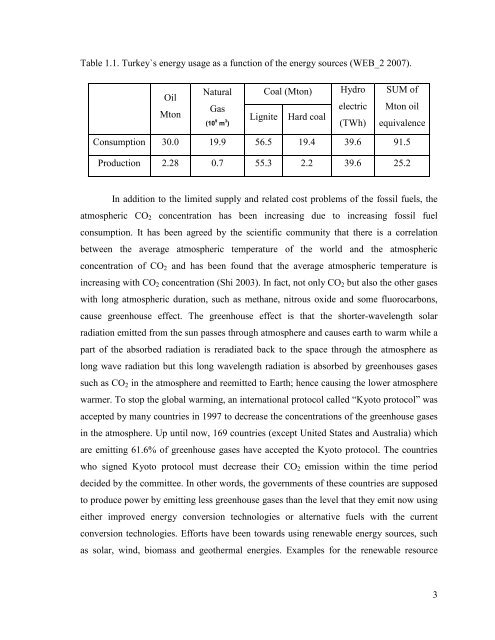hydrogen production from water using solar cells powered nafion ...
hydrogen production from water using solar cells powered nafion ...
hydrogen production from water using solar cells powered nafion ...
You also want an ePaper? Increase the reach of your titles
YUMPU automatically turns print PDFs into web optimized ePapers that Google loves.
Table 1.1. Turkey`s energy usage as a function of the energy sources (WEB_2 2007).<br />
Oil<br />
Mton<br />
Natural<br />
Gas<br />
(10 9 m 3 )<br />
Coal (Mton)<br />
Lignite Hard coal<br />
Hydro<br />
electric<br />
(TWh)<br />
SUM of<br />
Mton oil<br />
equivalence<br />
Consumption 30.0 19.9 56.5 19.4 39.6 91.5<br />
Production 2.28 0.7 55.3 2.2 39.6 25.2<br />
In addition to the limited supply and related cost problems of the fossil fuels, the<br />
atmospheric CO2 concentration has been increasing due to increasing fossil fuel<br />
consumption. It has been agreed by the scientific community that there is a correlation<br />
between the average atmospheric temperature of the world and the atmospheric<br />
concentration of CO2 and has been found that the average atmospheric temperature is<br />
increasing with CO2 concentration (Shi 2003). In fact, not only CO2 but also the other gases<br />
with long atmospheric duration, such as methane, nitrous oxide and some fluorocarbons,<br />
cause greenhouse effect. The greenhouse effect is that the shorter-wavelength <strong>solar</strong><br />
radiation emitted <strong>from</strong> the sun passes through atmosphere and causes earth to warm while a<br />
part of the absorbed radiation is reradiated back to the space through the atmosphere as<br />
long wave radiation but this long wavelength radiation is absorbed by greenhouses gases<br />
such as CO2 in the atmosphere and reemitted to Earth; hence ca<strong>using</strong> the lower atmosphere<br />
warmer. To stop the global warming, an international protocol called “Kyoto protocol” was<br />
accepted by many countries in 1997 to decrease the concentrations of the greenhouse gases<br />
in the atmosphere. Up until now, 169 countries (except United States and Australia) which<br />
are emitting 61.6% of greenhouse gases have accepted the Kyoto protocol. The countries<br />
who signed Kyoto protocol must decrease their CO2 emission within the time period<br />
decided by the committee. In other words, the governments of these countries are supposed<br />
to produce power by emitting less greenhouse gases than the level that they emit now <strong>using</strong><br />
either improved energy conversion technologies or alternative fuels with the current<br />
conversion technologies. Efforts have been towards <strong>using</strong> renewable energy sources, such<br />
as <strong>solar</strong>, wind, biomass and geothermal energies. Examples for the renewable resource<br />
3

















